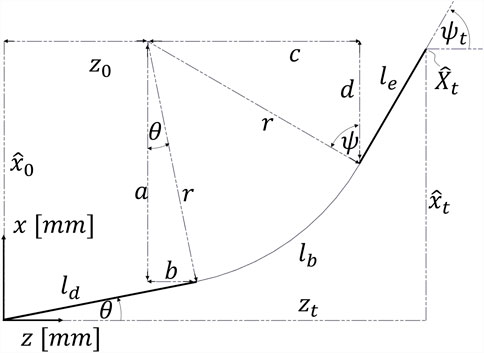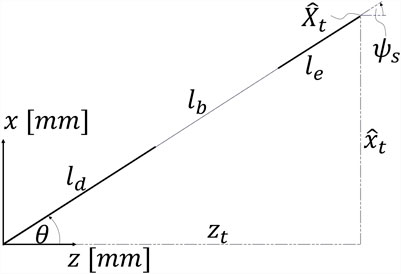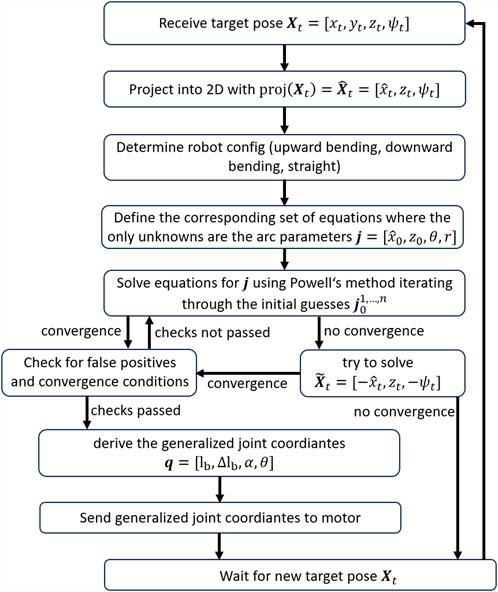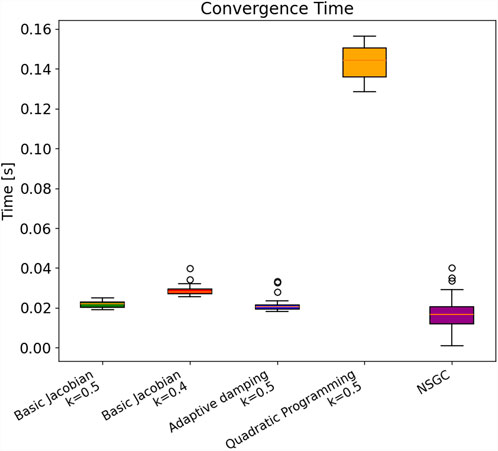- Department of Mechanical Engineering and Transport Systems, Technical University, Berlin, Germany
Inverse kinematics is a core problem in robotics, involving the use of kinematic equations to calculate the joint configurations required to achieve a target pose. This study introduces a novel inverse kinematic model (IKM) for extensible (i.e., length-adjustable) continuum robots (CRs) and hyper-redundant robots (HRRs) featuring an elbow joint. This IKM numerically solves a set of equations representing geometric constraints (abbreviated as NSGC). NSGC can handle target poses
1 Introduction
In recent years, the design and modeling of continuum robots (CRs) and hyper-redundant robots (HRRs) have garnered significant attention. CRs comprise multiple backbones routed in parallel and attached to a common end disk. Typically, CRs also incorporate spacer disks to maintain the backbone configuration and prevent buckling during actuation. On the other hand, HRRs consist of multiple rigid elements that can rotate relative to one another, enabling highly flexible and dexterous movements. Bending of the HRR is achieved through tendons routed through each segment. These tendons are connected to actuators that apply tension, inducing the desired curvature. Additional tendons control instruments located at the HRR’s end-effector. The inherent miniaturization potential of CRs and HRRs makes them well-suited for applications in minimally invasive surgery and endoscopy, where precision and maneuverability are essential.
1.1 A literature review of IKMs for CRs and HRRs
The most commonly used approach to modeling CRs and HRRs is the constant curvature model. CRs and HRRs with multiple segments can be modeled using the piecewise constant curvature model (Burgner-Kahrs et al., 2015). Using the Jacobian matrix to establish differential kinematics is the standard approach for CR/HRR inverse kinematic models (IKMs) (Whitney, 1972) and was also employed by Wolf et al. (2005), Garg et al. (2014), Guardiani et al. (2022), Lee et al. (2014), Li et al. (2017), Rone and Ben-Tzvi (2014), Simaan et al. (2009), Jones and Walker (2006), and Yeshmukhametov et al. (2019).
The generalized coordinates
Bajo et al. (2012) applied a Jacobian-based IKM to their IREP platform, which consists of two independent, two-segment CRs. They computed the Jacobian matrices for each segment individually.
Giorelli et al. (2013) proposed an alternative approach tailored to non-constant curvature CRs, where the static model is governed by nonlinear differential equations, making exact solutions challenging. As analytical solutions are unavailable, the elements of the Jacobian matrix cannot be computed directly. Instead, a feed-forward neural network is trained to learn the IKM for a non-constant curvature cable-driven manipulator. Similar neural network-based methods were presented by Lai et al. (2019) and Thuruthel et al. (2016).
Wei et al. (2023) presented an IKM for a two-segment HRR under the constant curvature assumption. They simplified the complex nonlinear system by reducing it to a single nonlinear equation, resulting in faster solutions.
Xu et al. (2018) adopted an iterative approach to compute the IKM utilizing a least squares method to determine the joint angles from specified cable lengths. Their model incorporated multilevel mappings that describe the relationships between motors and cables, cables and joints, and joints and the robot’s end-effector.
Almanzor et al. (2023) introduced a method that combines a local inverse kinematics formulation in image space with a deep convolutional neural network trained on synthetic data. A 2D hand-drawn image of the desired shape is used as the input, and the network predicts motor commands to drive the robot toward that shape. Closed-loop control is achieved using visual feedback from a webcam.
Wild et al. (2023) developed a novel piecewise dual quaternion algorithm to model multi-section CRs, aiming to improve the traditional pseudo-inverse Jacobian method. The piecewise dual quaternion approach offers reduced computational complexity, faster convergence, and smoother backbone configurations, especially as the number of robot sections increases.
Kim and Wi (2025) introduced a tendon-driven discrete CR using ball–socket joints. Between one and three robot units connected in series were tested by applying proximal tendon tension, while distal tension was gradually increased to induce bending. The resulting bending curves were interpolated using third-to-fifth-order polynomials.
Li et al. (2025) proposed a novel multilevel motion control method for HRRs based on joint angle–cable force cooperative optimization. It comprises a finite-time optimization approach using macro–micro decomposition to solve inverse kinematics. The high-degree-of-freedom (DoF) robot is divided into smaller manipulators and solved using a dual neural network model.
Using the space vector method, the manipulator’s kinematic model is developed to dynamically determine its endpoint position (Wang et al., 2024). The workspace is then generated through the Monte Carlo method. The original search approach is enhanced by introducing an angle-decoupling mechanism between adjacent links to calculate each joint’s rotation angles.
Zhan et al. (2024) introduced a general approach for solving the real-time optimized IKM of redundant robots, while strictly enforcing hard limits in both joint and Cartesian spaces that cannot be violated. Instead of quadratic programming, the method employs constrained linear programming to address the IKM problem. Hard constraints—including joint limits, velocity, and acceleration bounds—are explicitly managed as inequality constraints.
Sheng et al. (2024) presented an IKM method that combines the end-following approach with a segmented, Jacobian-based iterative solver for CRs with redundant DoF and a moving base. The end-following method is first used to generate a smooth, constraint-compliant initial joint configuration by having joints sequentially follow the target points along a planned path. This initial guess is then refined using Jacobian-based inverse kinematics applied to robot segments, thus improving accuracy while reducing the computation time.
The following subsection provides a brief overview of the Jacobian-based IKM.
1.2 Jacobian-based IKM
The state-of-the-art IKMs for CRs and HRRs are based on the Jacobian matrix
It should be noted that, in general, calculating the orientation difference requires careful handling beyond the simple subtraction of the target and achieved end-effector orientations.
The Jacobian matrix, as defined in Equation 1, is commonly used in the kinematics and dynamics of robotic systems. It relates variations in joint space to corresponding changes in configuration space.
The forward kinematic model of the robot describes the transformation matrices from the inertial frame
The Moore–Penrose inverse is computed using Equation 3.
Due to the iterative nature of the algorithm, the error converges against a predefined threshold that is considered acceptable by the user. The gain
This study introduces a novel IKM that departs from the traditional Jacobian-based approach. Instead, it relies on the numerical solution of a set of equations representing geometric constraints, referred to hereafter as NSGC. These equations are formulated using the unknown parameters of the arc representing the curvature of the bent CR/HRR. Solving this system enables the calculation of the robot’s length and bending parameters, which are subsequently converted into generalized coordinates
2 NSGC
Given a target pose
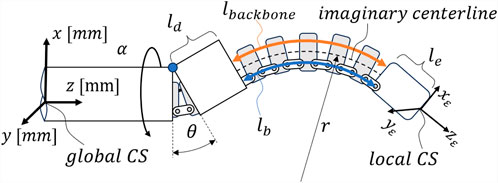
Figure 1. General CR/HRR structure suitable for NSGC: a proximal part that can be rotated about its main axis about angle
2.1 Projection from 3D space onto the 2D plane
The target pose
As shown in Figure 2, the angle
The projection does not affect
The projection of different robot configurations onto the global x–z-plane is displayed in Figure 2.
2.2 Robot configurations in 2D
Given a CR or HRR with an elbow joint and a length-adjustable bending part, the robot can achieve target poses
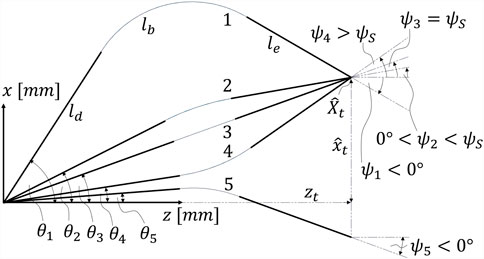
Figure 3. Different cases: robot 1: downward bending with
Generally, there are three possible robot configurations: downward bending, upward bending, and straight configuration. The distinction between the different cases is relevant as the equations representing the geometric constraints are slightly different for each case.
In the straight configuration, the distal part
2.3 Set of equations
For both downward and upward bending, the set of equations representing the geometric constraints is provided in Equations 8–11.
In Sections 2.4, 2.5, the placeholders a, b, c, and d are substituted by the arc parameters
2.4 Downward bending
For
Equations 8–11 can be trivially derived from the Pythagorean and angular relationships, as displayed in Figure 4. For downward bending, the placeholders a, b, c, and d, defined in the set of equations representing the geometric constraints (Equations 8–11), must be substituted as follows:
In the substituted set of equations, only the arc parameters
2.5 Upward bending
It is evident that the same straightforward geometric relationships described in the set of equations also apply to upward bending. For
The steps so far can be summarized as follows:
The given target pose
2.6 (Almost) Straight configuration
As
Finding a numerical solution where the variables approach infinity is unfeasible. Thus, to avoid divergence issues, in cases where the robot is straight or almost straight (i.e.,
Instead, the generalized coordinate
Thus, in case of a straight configuration, the generalized coordinates are
Reverting to a linear equation for the (almost) straight configuration ensures an extremely low runtime while maintaining acceptable accuracy. For the upward and downward bending scenarios, the set of equations is solved using Powell’s hybrid method, as described in the next subsection.
2.7 NSGC using Powell’s hybrid method
Powell’s hybrid method (Powell, 1970), also known as Powell’s dog-leg method, is an iterative optimization algorithm used to solve systems of nonlinear equations. It is designed to find the roots of systems of N nonlinear functions in N variables. In this article, it is used to numerically solve the set of nonlinear equations defined in Equations 8–11, where the placeholder variables a, b, c, and d are defined in Equations 12–15 for downward bending and in Equations 16–19 for upward bending. The objective function
where
Initialization:
Iteration:
1) Evaluate the function
2) Calculate the Gauss–Newton step using the Jacobian as defined in Equation 23
or its approximation as defined in Equation 24
If
3) Check whether the Gauss–Newton step is within the trust region as defined in Equation 25
Then, set
4) Calculate the Cauchy point: If the Gauss–Newton step is outside the trust region
The Cauchy point is then found by minimizing the quadratic function along the steepest descent direction as defined in Equation 27:
The multiplier
The Cauchy point is then given by
5) Determine the dog-leg step:
where
6) Update the solution:
7) Check for convergence: Evaluate the function at the new point and check whether the tolerance threshold or the maximum number of steps criterion is met. If either condition is satisfied, stop the iteration. Otherwise, repeat the process.
This method ensures global convergence by combining the Gauss–Newton direction with the steepest descent direction within a trust region, making it robust for the set of equations representing the geometric constraints.
2.8 Initial guesses
To ensure that NSGC finds a solution, it is necessary to provide multiple initial guesses
2.9 Projection with elbow joint constraints
If the projection of the target pose is always performed positively, such that
As mentioned in Section 2.1, it is not known a priori whether a given target pose
Here, the variables
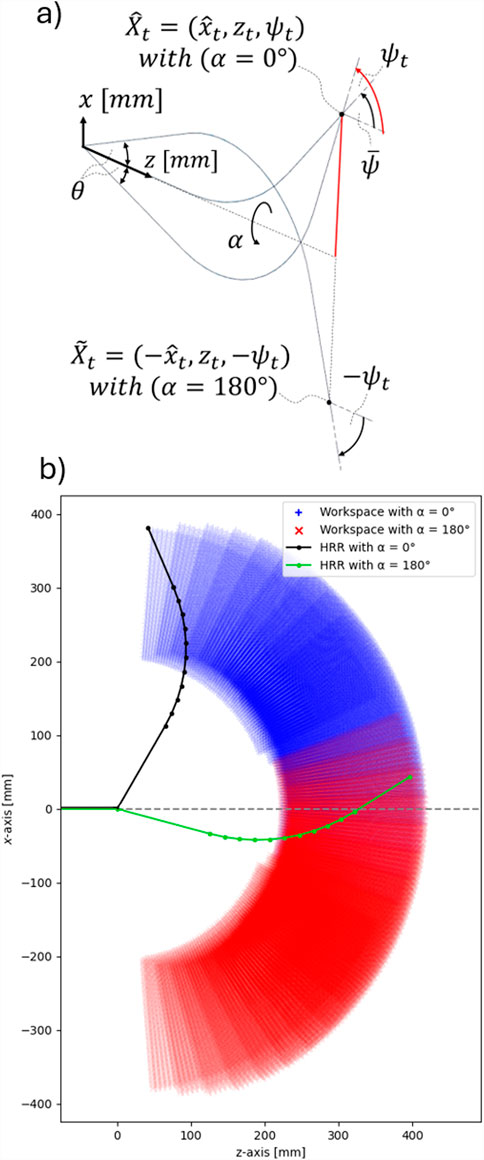
Figure 7. (a) Utilizing
This rotation about the main axis significantly enlarges the workspace, as shown in Figure 7b. When a target pose is only reachable via this axial rotation, the projected pose must be transformed as
2.10 False positives and convergence conditions
NSGC can provide false positives that are mathematically correct but do not represent the physical robot. The predominant cases of false positives are shown in Figure 8.
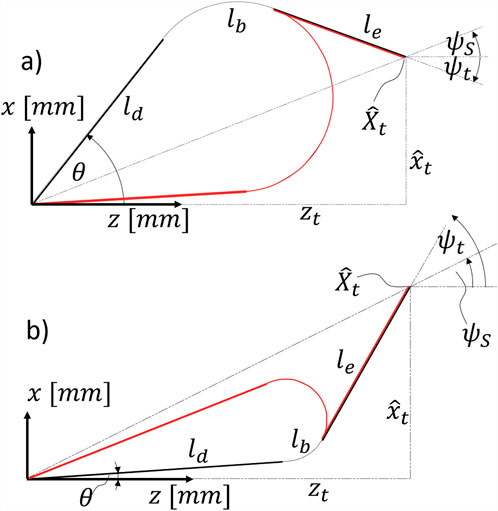
Figure 8. Black robots are correct, and the red robots are false positives. (a) Downward bending: instead of having
It must be ensured that the algorithm does not accept a false positive as a numerical solution. Thus, for each solution is checked against the following three convergence conditions:
I. 0°
II. If
III. If
It should be noted that for upward bending, condition III is stronger than the statement “if
2.11 Getting from numerical solution to generalized coordinates
Using the numerically computed deflection angle
To derive the resulting end-effector pose based on the NSGC solution for the generalized joint coordinates
2.12 Overview of NSGC
In summary, the final NSGC algorithm is expressed in Algorithm 2. Here,
The flowchart in Figure 9 visualizes the individual steps of the NSGC algorithm.
3 In silico validation
The proposed NSGC algorithm was implemented and compared with four state-of-the-art IKMs following a helical trajectory: two basic Jacobian-based models with k-factor values of 0.4 and 0.5, one Levenberg–Marquardt (LM) implementation with adaptive damping, and one quadratic programming approach. The LM technique is also known as damped least squares in optimization. A k-factor of 0.5 was the highest value that still allowed all target poses to be achieved. The comparison included the accuracy, median, mean, range, IQR, and standard deviation of the convergence times for 200 target poses
3.1 Convergence time and behavior
The convergence times for all five IKMs are visualized in Figure 10 and summarized in Table 1. The mean convergence times of basic Jacobians and the adaptive damping LM IKMs are very similar to each other (in the range of
It has to be noted that the spread of convergence time of NSGC
The convergence behavior of NSGC is displayed in Figure 11. As observed, NSGC iterates through different initial guesses until it finds the correct solution for the set of equations defined in Section 2.3. It is evident that NSGC’s convergence behavior is fundamentally different from that of all other IKM approaches (Figure 11) as there is no convergence in the sense that the error progressively approaches 0. Rather, the convergence of an iteration is completely independent of the previous iteration’s convergence, as it depends solely on the initial guess. Note that the convergence time is not only influenced by the number of iterations until convergence but also by the time needed per iteration. Generally, NSGC and the quadratic programming approach need more time per iteration.
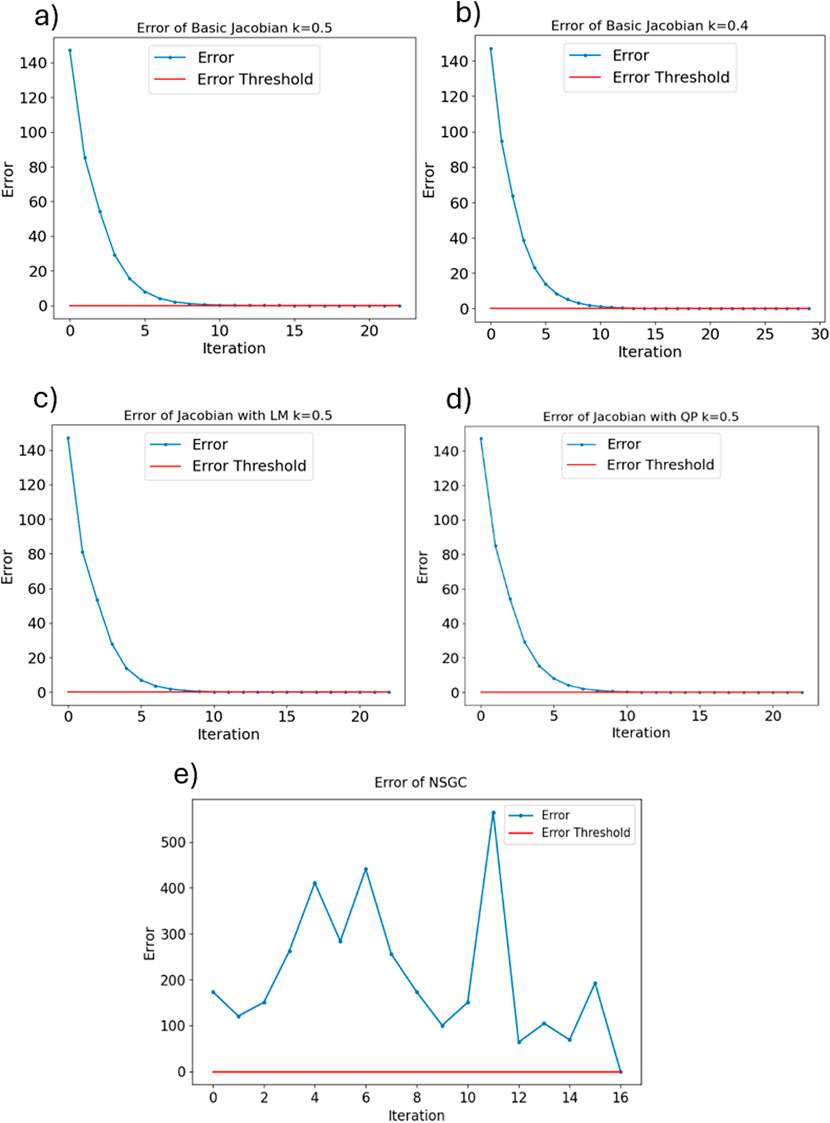
Figure 11. Comparison of convergence behavior of NSGC vs. Jacobian-based IKMs with an error threshold of 1e-5. (a) the basic jacobian IKM with k=0.5 converges after 22 steps. (b) the basic jacobian IKM with k=0.4 converges after 29 steps. (c) the LM IKM converges after 22 steps. (d) the QP IKM converges after 22 steps, but each step takes significantly longer than using the basic Jacobian-based IKM. (d) NSGC needs 16 steps.
3.2 Memory footprint and computational complexity
The NSGC algorithm, implemented in Python, exhibits a moderate memory footprint and computational complexity.
3.2.1 Memory footprint
The memory usage of NSGC is primarily driven by the number of initial guesses for solving the nonlinear system, with each being a 4-dimensional vector initial_guesses list. Let
3.2.2 Computational complexity
The dominant cost arises from numerically solving a nonlinear system of four equations with four unknowns using Powell’s method. For each initial guess, it performs iterative updates until convergence, which typically takes
Let
The overall complexity becomes
where
3.2.3 Practical performance
Empirical results indicate solution times in the range of tens of milliseconds on a modern CPU, depending on the initial guess set and configuration. Memory remains bounded and scales linearly with the resolution and number of guesses, making the algorithm suitable for embedded applications with moderate resources.
3.3 Robustness to noise, initial guess sensitivity, and singularities
The NSGC algorithm demonstrates high robustness in practical inverse kinematic scenarios but retains certain sensitivities that merit discussion.
3.3.1 Robustness to noise
When using NSGC, the user has free choice of the position
3.3.2 Sensitivity to initial guess
The choice of initial guesses significantly impacts both convergence success and computational efficiency. While NSGC employs a coarse angular sweep strategy to sample possible solution regions, poorly chosen or sparse guess sets can lead to missed solutions or divergence. Empirical evidence suggests that a resolution of approximately 10° for the initial guess of
3.3.3 Singularities and degenerate configurations
The algorithm can struggle near geometric singularities, such as when the NiTi segment length
Overall, good initial guesses, checking for false positives, and establishing a straight-line case for divergent bending radii ensure NSGC’s performance, stability, and accuracy considerably.
3.4 Simulated case study
As CRs/HRRs are used in endoscopy (Sun and Chen, 2024) and biopsy procedures (Gao et al., 2020), this study uses endoscopic examination of the gallbladder as a case study. During a biopsy, the physician traverses the surface of the organ, and once a suitable location is identified, the biopsy needle is inserted into the tissue.
According to Can et al. (2012), the average gallbladder size is
The following section describes the robotic prototype used for the experimental validation.
4 HyNiTi prototype
The robotic prototype is referred to as a hyper-redundant, NiTi-based robot (abbreviated as HyNiTi). The robot’s dexterity stems from its ability to adjust the length and incorporate an elbow joint, enabling multiple orientations at the same position (Fritsch et al., 2024).
The HyNiTi features four motors (motors 1–4 in Figure 12) for robot actuation, resulting in four DoFs of the robot. Additionally, there is one motor (motor 5 in Figure 12) for instrument actuation (i.e., advancing and retracting the biopsy needle). The entire robot is rotated about its main axis by approximately
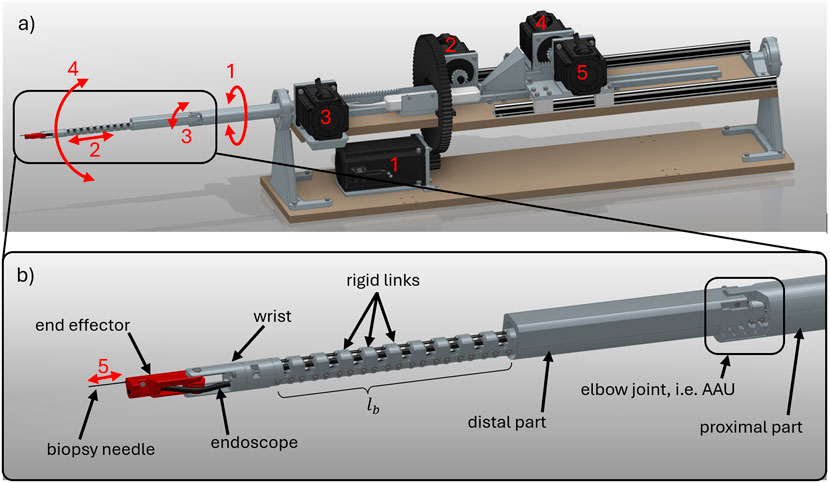
Figure 12. CAD model of HyNiTi: (a) complete robot including motors and (b) details of HRR; scale:
The endoscope (K-FLEX-XC1, Karl Storz SE & Co. KG, Tuttlingen, Germany) is routed through the HRR to its end-effector. The endoscope is not directly actuated but complies with the shape of the HRR. The endoscope features a
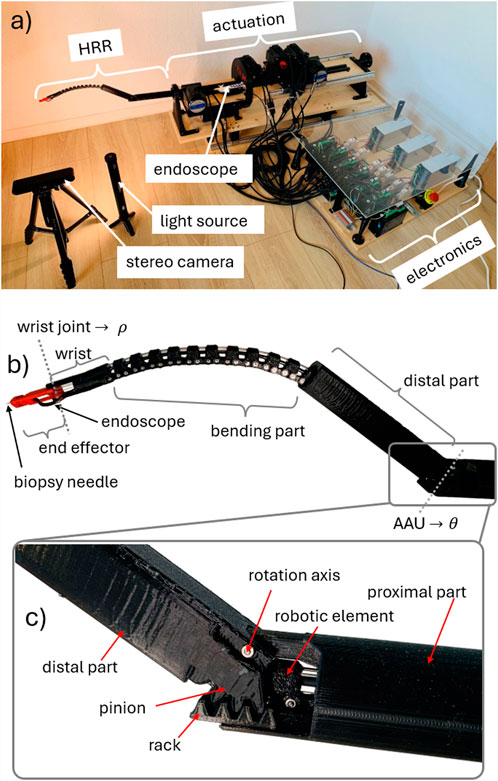
Figure 13. Robotic prototype: (a) test setup, (b) HRR details, and (c) elbow joint for scale: distal part of this prototype is
4.1 HRR actuation
HyNiTi is an HRR that relies on backbone actuation. The backbone is made of highly elastic metal, such as superelastic NiTi or spring steel. Unlike tendons, the backbone is resistant to stretching and backlash, resulting in more stable and predictable robotic behavior.
Another advantage of this design is the reduced number of channels within the robotic elements. Tendon-driven systems typically require separate channels for each bending direction (e.g., one tendon for upward bending and another for downward bending). In contrast, the pull–push backbone actuation requires only one channel to facilitate movement in two opposing directions, enabling further miniaturization of the robot.
4.2 Elbow joint design
The prototype utilizes an elbow joint that is based on a rack–and-pinion mechanism (Fritsch et al., 2023). The rack is pushed or pulled by a motor (in this case, by motor 3), causing the pinion to rotate about the axis of rotation. The pinion is structurally integrated into the distal part. To mitigate the risk of tilting or jamming of the distal part, the rack and pinion mechanism is designed with redundancy, incorporating a two-sided configuration.
The elbow joint’s deflection angles are in the range of 0°
5 Experimental validation
The NSGC algorithm was tested using the HyNiTi robot. The complete test setup is shown in Figure 13a. A stereo camera (ZED 2i, Stereolabs, San Francisco, United States) was used for the optical measurement of the achieved poses. The depth information enables the localization of points in 3D so that the x, y, and z coordinates can be derived with respect to the camera. The camera is extrinsically calibrated to the global coordinate system, which is located at the robot’s base. Each of the measured points is transformed into the global coordinate system.
In this setup, each stepper motor features an optical incremental encoder, and the drivers handle the PID control internally; thus, there is low-level closed-loop control. The joint position commands are generated using NSGC and then fed to the stepper motor drivers using a microcontroller.
5.1 Individual target poses
A total of 100 target poses
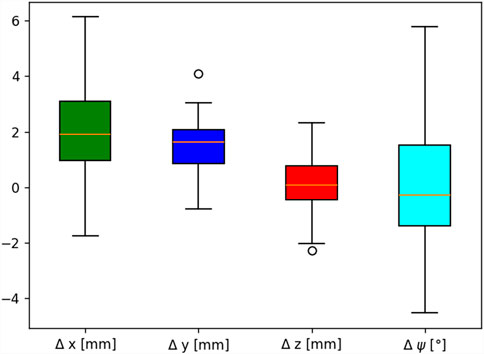
Figure 14. Deviation between the measured pose and target pose for 100 individual target poses in 3D.
As shown in Figure 14, the range of error was the highest for the end-effector angle
5.2 Trajectory tracking
For the application of CR/HRR technology in the real world, good trajectory tracking performance is crucial. In this experiment, three trajectories were tracked: a linear

Figure 15. Trajectory tracking: left plot: end-effector tracking along the x-axis from +
The inverse kinematics for each point on the helix was computed using the proposed NSGC algorithm. The orientation at each point was kept constant; in other words, the end-effector reached each pose on the trajectory with the same orientation. In all three cases, the target trajectory was compared against the measured trajectory. During trajectory tracking, an image was captured and analyzed every
The average positional error during trajectory tracking was
The inaccuracies are due to the mechanical structure of the robot: play in the joints connecting the rigid links in the bending section and a relatively heavy end-effector, which causes low-frequency mechanical vibrations.
5.3 Case study: gallbladder biopsy
The HyNiTi prototype, equipped with a biopsy needle and an endoscopic camera (as described in Section 4), was used in this case study to simulate a biopsy on a piece of meat representing the gallbladder. The objective of this case study is to demonstrate NSGC’s effectiveness in real-life applications.
Three distinct target locations were selected on the tissue sample. Position 1 was aligned along the main axis of the proximal region, while positions 2 and 3 were located on the top and bottom surfaces of the tissue, respectively. Reaching these off-axis targets required actuation of the robot’s rotational degree of freedom, denoted as
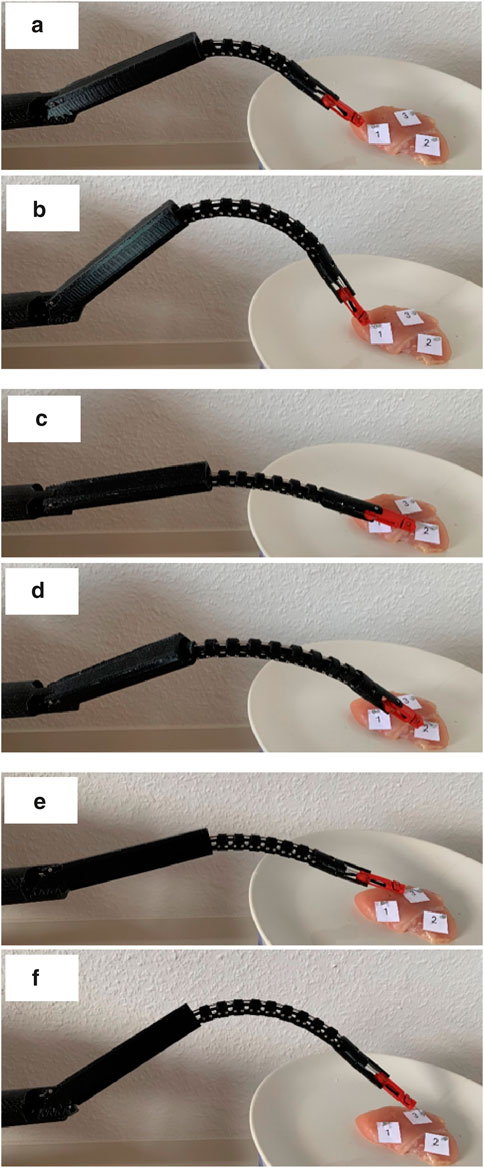
Figure 16. Case study of three target locations on the tissue: (a) target position 1 is reached at an angle
6 Conclusion
In this article, a novel inverse kinematic model termed NSGC was introduced—a numerical solution of a set of equations representing geometric constraints. NSGC is well-suited for length-extensible CRs and HRRs featuring an elbow joint.
A target pose
The HRR prototype relied on backbone actuation, which proved to work reliably and without any backlash or elongation compared to tendon actuation. The elbow joint allowed for precise and repeatable deflection of the HRR away from the proximal part’s main axis. Changing the orientation at the same position was enabled by the combination of the elbow joint and the length adjustment of the HRR.
The limitation of NSGC is the narrow range of kinematic structures for which it can be used; the discussed CR/HRR structure with length-adjustment capabilities and an elbow joint can only achieve a position in 3D space and with one orientation about the local
In the current trajectory-tracking validation, NSGC is used to compute the generalized joint coordinates
A drawback is the diverging radius as the robot configuration approaches a straight line (i.e.,
Another limitation of this study is that only the positions were considered for trajectory tracking. In future studies, orientation should also be taken into consideration, as was done during the measurement of the individual target poses.
Data availability statement
Publicly available datasets were analyzed in this study. This data can be found here: https://github.com/SvenFritschResearch/NSGC/tree/main.
Author contributions
SF: Conceptualization, Formal Analysis, Methodology, Software, Writing – original draft, Writing – review and editing. DO: Funding acquisition, Project administration, Resources, Supervision, Writing – review and editing.
Funding
The author(s) declare that financial support was received for the research and/or publication of this article. This open access publication was supported by the publication fund of Technical University Berlin.
Acknowledgments
The authors express gratitude to Karl Storz SE & Co. KG for supporting this research by providing the endoscope.
Conflict of interest
The authors declare the following financial interests/personal relationships which may be considered as potential competing interests: Technical University Berlin has patented the angle adjustement unit under file number 10 2021 128 809.6 at the German Patent Office. Inventors are Sven Fritsch and Dirk Oberschmidt.
Generative AI statement
The author(s) declare that no Generative AI was used in the creation of this manuscript.
Publisher’s note
All claims expressed in this article are solely those of the authors and do not necessarily represent those of their affiliated organizations, or those of the publisher, the editors and the reviewers. Any product that may be evaluated in this article, or claim that may be made by its manufacturer, is not guaranteed or endorsed by the publisher.
Supplementary material
The Supplementary Material for this article can be found online at: https://www.frontiersin.org/articles/10.3389/frobt.2025.1627688/full#supplementary-material
References
Almanzor, E., Ye, F., Shi, J., Thuruthel, T. G., Wurdemann, H. A., and Iida, F. (2023). Static shape control of soft continuum robots using deep visual inverse kinematic models. IEEE Trans. Robotics 39, 2973–2988. doi:10.1109/tro.2023.3275375
Bajo, A., Goldman, R. E., Wang, L., Fowler, D., and Simaan, N. (2012). “Integration and preliminary evaluation of an insertable robotic effectors platform for single port access surgery,” in IEEE international conference on robotics and automation.
Burgner-Kahrs, J., Rucker, D., and Choset, H. (2015). “Continuum robots for medical applications: a survey,” in IEEE transactions on robotics.
Can, S., Staub, C., Knollm, A., Fiolka, A., Schneider, A., and Feussner, H. (2012). “Design, development and evaluation of a highly versatile robot platform for minimally invasive single-port surgery,” in The fourth IEEE RAS/EMBS international conference on biomedical robotics and biomechatronics.
Chen, H.-S., and Stadtherr, M. (1981). A modification of Powell’s dogleg method for solving systems of nonlinear equations. Urbana, IL: Computers & Chemical Engineering, University of Illinois, 143–150.
Chirikjian, G., and Burdick, J. W. (1994). “A hyper-redundant manipulator,” in IEEE robotics and automation magazine.
Fritsch, S., and Oberschmidt, D. (2023). Articulating robotic arm for minimally invasive surgery, surgical robot and method for production. U. S. Pat. App 17/981, 279. Available online at: https://patents.google.com/patent/US20230145905A1/en.
Fritsch, S., and Oberschmidt, D. (2024). Getting from a 3D, dexterous, single-port workspace to a one-segment continuum robot. Mechatronics 101, 103194. doi:10.1016/j.mechatronics.2024.103194
Gao, Y., Takagi, K., Kato, T., Shono, N., and Hata, N. (2020). Continuum robot with follow-the-leader motion for endoscopic third ventriculostomy and tumor biopsy. IEEE Trans. Biomed. Eng. 67 (2), 379–390. doi:10.1109/tbme.2019.2913752
Garg, A., Vikram, C. S., and Gupta, V. K. (2014). “Design and development of in vivo robot for biopsy,” in Mechanics based design of structures and machines: an international journal.
Giorelli, M., Renda, F., Ferri, G., and Laschi, C. (2013). A feed-forward neural network learning the inverse kinetics of a soft cable-driven manipulator moving in three-dimensional space. IEEE/RSJ International Conference on Intelligent Robots and Systems IROS.
Guardiani, P., Ludovico, D., Pistone, A., Abidi, H., Zaplana, I., Lee, J., et al. (2022). “Design and analysis of a fully actuated cable-driven joint for hyper-redundant robots with optimal cable routing,” in Journal of mechanisms and robotics.
John, B. (1983). “Kinematic programming alternatives for redundant manipulators,” in Proceedings of the IEEE international conference on robotics and automation.
Jones, B. A., and Walker, I. D. (2006). “Kinematics for multisection continuum robots,” in IEEE transactions on robotics.
Kim, Y.-J., and Wi, D. (2025). Planar inverse statics and path planning for a tendon-driven discrete continuum robot. Robotics 14, 91. doi:10.3390/robotics14070091
Klein, C. A., and Huang, C.-H. (1983). “Review of pseudoinverse control for use with kinematically redundant manipulators,” in IEEE transactions on systems, man, and cybernetics.
Lai, J., Huang, K., and Henry, K. (2019). “Chu. “A learning-based inverse kinematics solver for a multi-segment continuum robot in robot-independent mapping”,” in Proceedings of the IEEE international conference on robotics and biomimetics.
Lee, J., Kim, J., and Choi, J.-Y. (2014). Modeling and control of robotic surgical platform for single-port access surgery. IEEE/RSJ International Conference on Intelligent Robots and Systems.
Li, M., Kang, R., Geng, S., and Guglielmino, E. (2017). “Design and control of a tendon-driven continuum robot,” in Transactions on the institute of measurement and control.
Li, Z., Zheng, S., Zhang, Y., Li, H., Jiang, Z., and Shi, P. (2025). “Multilevel motion control of cable-driven hyper-redundant manipulators,” in IEEE/ASME transactions on mechatronics.
Powell, M. (1970). “A hybrid method for nonlinear equations,” in Numerical methods for nonlinear algebraic equations, 87–144.
Rone, W. S., and Ben-Tzvi, P. (2014). “Mechanics modeling of multisegment rod-driven continuum robots,” in Journal of mechanisms and robotics.
Seraji, H. (1989). “Configuration control of redundant manipulators: theory and implementation,” in IEEE transactions on robotics and automation.
Sheng, Z., Wang, Y., Li, S., Yang, J., Xie, H., and Lu, X. (2024). Research on kinematics modeling and path planning of a hyper-redundant continuum robot. Proc. Institution Mech. Eng. Part C J. Mech. Eng. Sci. 238 (12), 5880–5890. doi:10.1177/09544062231224967
Simaan, N., Xu, K., and Taylor, R. (2009). “Design and integration of a telerobotic system for minimally invasive surgery of the throat,” in International journal of robotics research.
Sun, L., and Chen, X. (2024). “Flexible continuum robot system for minimally invasive endoluminal gastrointestinal endoscopy,” in Machines 12.
Thuruthel, T., Falotico, E., and Laschi, C. (2016). “Learning global inverse kinematics solutions for a continuum robot,” in Dynamics and control.
Wang, Z., Hu, D., Wan, D., and Liu, C. (2024). An improved inverse kinematics solution method for the hyper-redundant manipulator with end-link pose constraint. J. Field Robotics 41 (6), 1900–1921. doi:10.1002/rob.22362
Wei, H., Zhang, G., Wang, S., Zhang, P., Su, J., and Du, F. (2023). “Coupling analysis of compound continuum robots for surgery: another line of thought,” in Sensors.
Whitney, D. E. (1972). “The mathematics of coordinated control of prosthetic arms and manipulators,” in Journal of dynamic systems, measurement, and control.
Wild, S., Zeng, T., Mohammad, A., Billingham, J., Axinte, D., and Dong, X. (2023). “Efficient and scalable inverse kinematics for continuum robots,” in IEEE robotics and automation letter, 9.1.
Wolf, A., Howard, H. C., and Randall, C. (2005). “Design and control of a mobile hyperredundant urban search and rescue robot,” in Advanced robotics.
Xu, W., Liu, T., and Li, Y. (2018). “Kinematics, dynamics, and control of a cable-driven hyper-redundant manipulator,” in IEEE/ASME transactions on mechatronics.
Yeshmukhametov, A., Koganezawa, K., and Yamamoto, Y. (2019). “A novel discrete wire-driven continuum robot arm with passive sliding disc: design, kinematics and passive tension control,” in Robotics.
Keywords: continuum robots, hyper-redundant robots, inverse kinematics, optimization algorithm, robot control
Citation: Fritsch S and Oberschmidt D (2025) A projection-based inverse kinematic model for extensible continuum robots and hyper-redundant robots with an elbow joint. Front. Robot. AI 12:1627688. doi: 10.3389/frobt.2025.1627688
Received: 13 May 2025; Accepted: 21 July 2025;
Published: 12 September 2025.
Edited by:
Hani J. Marcus, University College London, United KingdomReviewed by:
Dler Salih Hasan, Salahaddin University, IraqAzamat Yeshmukhametov, Nazarbayev University, Kazakhstan
Copyright © 2025 Fritsch and Oberschmidt. This is an open-access article distributed under the terms of the Creative Commons Attribution License (CC BY). The use, distribution or reproduction in other forums is permitted, provided the original author(s) and the copyright owner(s) are credited and that the original publication in this journal is cited, in accordance with accepted academic practice. No use, distribution or reproduction is permitted which does not comply with these terms.
*Correspondence: Dirk Oberschmidt, ZGlyay5vYmVyc2NobWlkdEB0dS1iZXJsaW4uZGU=
 Sven Fritsch
Sven Fritsch Dirk Oberschmidt*
Dirk Oberschmidt*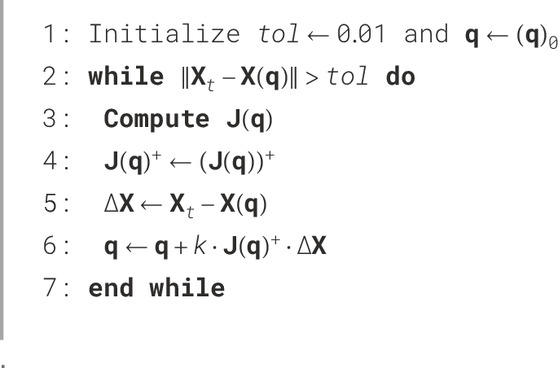

![Graph depicting a segmented curve with variables labeled. Axes are marked as \(x [mm]\) and \(z [mm]\). Key segments and angles include \(l_d\), \(l_e\), \(\theta\), \(\psi_t\), and \(r\). Distances \(a\), \(b\), \(c\), and \(d\) are noted, along with coordinates \(\hat{x}_0\), \(z_0\), \(\hat{x}_t\), and \(z_t\). Geometric relationships are illustrated using dashed lines and angle arcs.](https://www.frontiersin.org/files/Articles/1627688/frobt-12-1627688-HTML-r1/image_m/frobt-12-1627688-g004.jpg)
